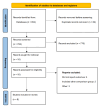Comparative Cardiovascular Outcomes of Dapagliflozin Versus Empagliflozin in Patients With Type 2 Diabetes: A Meta-Analysis
- PMID: 40322609
- PMCID: PMC12050029
- DOI: 10.7759/cureus.83449
Comparative Cardiovascular Outcomes of Dapagliflozin Versus Empagliflozin in Patients With Type 2 Diabetes: A Meta-Analysis
Abstract
Sodium-glucose co-transporter-2 (SGLT2) inhibitors have demonstrated significant cardiovascular benefits in patients with type 2 diabetes. However, head-to-head comparisons between dapagliflozin and empagliflozin, two widely prescribed SGLT2 inhibitors, remain limited. This meta-analysis aimed to directly compare the cardiovascular outcomes of these agents in patients with type 2 diabetes. We conducted a comprehensive literature search across multiple databases and included eight retrospective studies enrolling 280,617 patients (158,352 receiving empagliflozin and 122,265 receiving dapagliflozin). The primary outcome was major adverse cardiovascular events (MACE), with secondary outcomes including all-cause mortality, myocardial infarction, and stroke. Our pooled analysis revealed no significant difference in MACE risk between empagliflozin and dapagliflozin (RR: 1.04; 95% CI: 0.96 to 1.13). Similarly, no significant differences were observed for all-cause mortality (RR: 1.05; 95% CI: 0.96 to 1.15), myocardial infarction (RR: 1.04; 95% CI: 0.94 to 1.16), or stroke (RR: 1.00; 95% CI: 0.91 to 1.09). Subgroup analyses by gender, atherosclerotic cardiovascular disease, and chronic kidney disease status showed consistent results. However, in patients with heart failure, a trend toward reduced MACE risk was observed with empagliflozin (RR: 0.90; 95% CI: 0.82 to 1.00). Despite pharmacokinetic differences between these agents, our findings suggest comparable cardiovascular outcomes in patients with type 2 diabetes, with potentially enhanced benefits of empagliflozin in those with heart failure. However, due to lack of studies, this finding should be interpreted with caution. These results provide valuable insights for clinical decision-making when selecting SGLT2 inhibitors for cardiovascular risk reduction in diabetic patients. Further prospective studies are warranted to confirm these findings and explore potential mechanistic differences between these agents.
Keywords: cardiovascular outcomes; dapagliflozin; empagliflozin; sglt2 inhibitors; type 2 diabetes.
Copyright © 2025, Dhana et al.
Conflict of interest statement
Conflicts of interest: In compliance with the ICMJE uniform disclosure form, all authors declare the following: Payment/services info: All authors have declared that no financial support was received from any organization for the submitted work. Financial relationships: All authors have declared that they have no financial relationships at present or within the previous three years with any organizations that might have an interest in the submitted work. Other relationships: All authors have declared that there are no other relationships or activities that could appear to have influenced the submitted work.
Figures





Similar articles
-
Cardiovascular outcomes between dapagliflozin versus empagliflozin in patients with diabetes mellitus.Clin Cardiol. 2024 Feb;47(3):e24248. doi: 10.1002/clc.24248. Clin Cardiol. 2024. PMID: 38436204 Free PMC article.
-
The Comparison of the Effectiveness of Dapagliflozin and Empagliflozin in the Prevention of Cardiovascular Outcomes in Patients With Type 2 Diabetes: A Network Meta-Analysis.Cureus. 2024 Sep 19;16(9):e69711. doi: 10.7759/cureus.69711. eCollection 2024 Sep. Cureus. 2024. PMID: 39429324 Free PMC article. Review.
-
Meta-Analysis of Cardiovascular Efficacy of Empagliflozin Versus Dapagliflozin in Type 2 Diabetes: Unveiling Key Insights.Cardiol Rev. 2025 Apr 17. doi: 10.1097/CRD.0000000000000916. Online ahead of print. Cardiol Rev. 2025. PMID: 40243298
-
Comparison of Cardiovascular Outcomes Between Dapagliflozin and Empagliflozin in Patients With Type 2 Diabetes: A Meta-Analysis.Cureus. 2022 Jul 26;14(7):e27277. doi: 10.7759/cureus.27277. eCollection 2022 Jul. Cureus. 2022. PMID: 36039257 Free PMC article. Review.
-
Comparative risk evaluation for cardiovascular events associated with dapagliflozin vs. empagliflozin in real-world type 2 diabetes patients: a multi-institutional cohort study.Cardiovasc Diabetol. 2019 Sep 24;18(1):120. doi: 10.1186/s12933-019-0919-9. Cardiovasc Diabetol. 2019. PMID: 31551068 Free PMC article.
References
-
- Risk factors, mortality, and cardiovascular outcomes in patients with type 2 diabetes. Rawshani A, Rawshani A, Franzén S, et al. N Engl J Med. 2018;379:633–644. - PubMed
-
- Empagliflozin, cardiovascular outcomes, and mortality in type 2 diabetes. Zinman B, Wanner C, Lachin JM, et al. N Engl J Med. 2015;373:2117–2128. - PubMed
-
- Canagliflozin and cardiovascular and renal events in type 2 diabetes. Neal B, Perkovic V, Mahaffey KW, et al. N Engl J Med. 2017;377:644–657. - PubMed
Publication types
LinkOut - more resources
Full Text Sources
